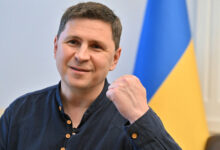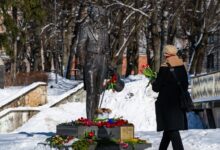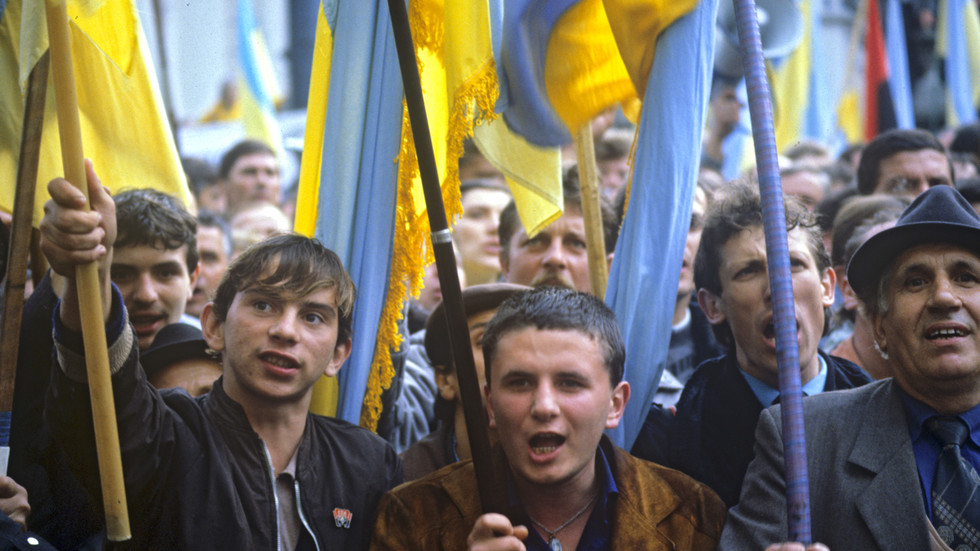
Ukrainian nationalists were persecuted and imprisoned in the USSR but had many allies in circles of power

FILE PHOTO. Rally called for by the People’s Movement of Ukraine (RUKH) outside the building of the Supreme Council proesting against the new union treaty. © Sputnik/Igor Kostin
The end of the Second World War and the defeat of Ukrainian Nazi-collaborators did not put an end to the nationalist movement in the Soviet republic. On the contrary, realizing the futility of underground armed struggle, the “patriots” took the opposite approach. Thus, political leaders in Kiev became unwitting accomplices, who actively continued the work begun in the 1920s to “Ukrainianize” territories inhabited by a mainly Russian population.
Thanks to this, representatives of the Ukrainian national movement began to engage in human rights activities, while simultaneously raising ethnic issues. It resulted in the creation of the People’s Movement of Ukraine party, known as Rukh, which became the driving force that led the country to independence in 1991. Like other nationalists, they played an important role in the collapse of the Soviet Union.
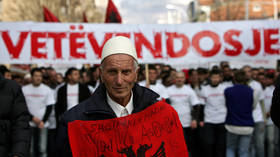
Read more
Not Everyone’s Thaw
Repressions against dissidents resumed in the Soviet Union immediately after the end of World War II. In the Ukrainian SSR, this was mainly seen in the struggle against the Organization of Ukrainian Nationalists (OUN), an underground political organization created in the late 1920s, which operated in Galicia and Volhynia. During the War, members of the OUN organized an insurgent army that fought on the side of Nazi Germany. They were aided by sympathetic residents of the Ukrainian SSR’s western regions, which had been annexed in 1939. However, the death of Joseph Stalin and the debunking of his cult of personality put an end to the practice of mass repression. A period of so-called ‘thaw’ began under Khrushchev – a transition from totalitarianism to a milder dictatorship.
Censorship weakened, freedom of speech increased, and there was a relative liberalization of political and public life. As a result, nationally minded Ukrainians gained a certain degree of freedom of expression without the risk of being arrested. However, with the destruction of the OUN underground, they had already become disillusioned with any form of armed struggle. Being mostly intellectuals, they preferred to express themselves not by deeds, but in words.
There were opportunities for this approach. Kiev’s regional committee was headed by Petr Shelest, a native of Slobozhanshchina (the village of Andreevka near Kharkov). Later, during the thaw, he led the Communist Party of the Ukrainian SSR. During his incumbency, the next stage of Ukrainization began in the republic. He switched to the Ukrainian language himself after his appointment as the Ukrainian SSR’s top official. “Suddenly, small restaurants and taverns with ‘Ukrainian’ names appeared (‘Kuren’, ‘Natalka-Poltavka’, etc.) in the vicinity of Kiev, with elements of Ukrainian ethnography in design and service… Signs with the word ‘Ukraine’ began to appear on various shopping establishments and the like,” recalled Ukrainian writer and literary critic Ivan Dziuba.
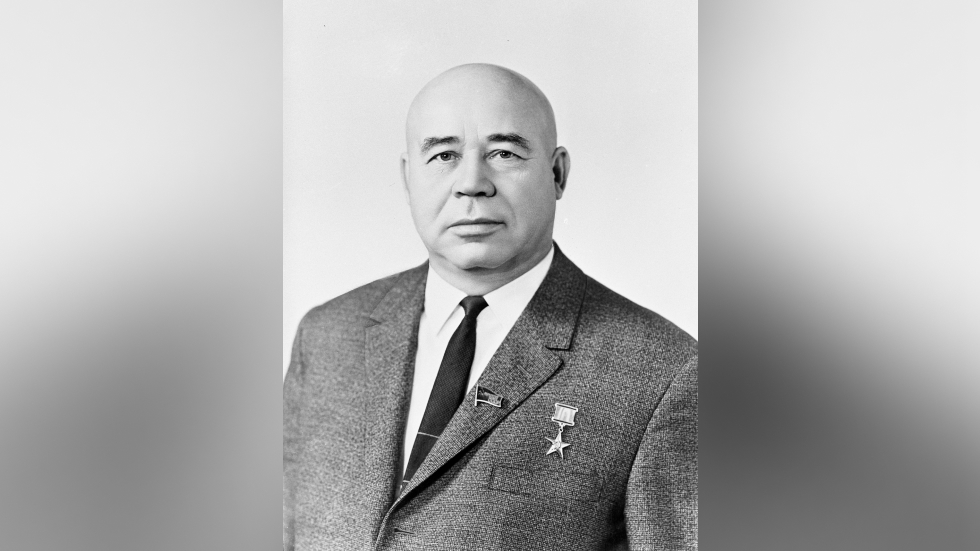
Pyotr Shelest, First Secretary of the Ukrainian Communist Party Central Committee, Presidium member of the Politburo of the CPSU Central Committee, deputy Chairman of the USSR Council of Minsters. © Sputnik/Rykov
In the 1960s, in parallel with the next stage of Ukrainization both from above and below, a new constellation of figures began to form in the Ukrainian national movement. Their first meetings were held in a cinema club at the former Kiev Institute of Noble Maidens, which the Bolsheviks had renamed the October Palace. Young writers, artists, musicians, actors, and directors met there. Among them were Ivan Dziuba, Evgeny Sverstyuk, and Alla Gorskaya, who were to become major figures in the Ukrainian movement.
A Turn to Politics
Soon these creative meetings acquired political undertones. In 1962, artist Alla Gorskaya and poet Vasily Simonenko discovered Bykovnya (now the ‘Bykovnyanskie Graves’ National Historical Memorial) in Kiev and its environs, as well as Vasilkov, which was the killing grounds of the NKVD [the country’s central state agency security, which was replaced by the MSS, and then the KGB – RT], where at least 7,000 victims of Stalin’s repressions were shot and buried from 1937 to 1941.
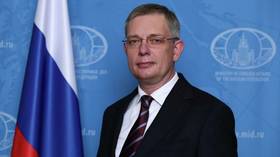
Read more
They sent a letter to Kiev’s City Council demanding that the existence of these mass graves be made public and turned into a memorial to the victims of Stalin’s terror. At the same time, Ukrainian intellectuals began to oppose what they considered to be the excessive presence of the Russian language in the Ukrainian SSR’s public life, while condemning ideological restrictions on creativity, and so forth. There was no talk about independence yet, but the movement for civil and national rights was constantly strengthening.
1965 became a landmark year. In September, the film Shadows of Forgotten Ancestors by dissident director Sergey Parajanov premiered in Kiev. It tells the story of two young lovers from warring Western Ukrainian families. Before the screening, the director made a speech, and then literary critic Ivan Dziuba, graduate student Vasily Stus, and journalist Vyacheslav Chornovol took the stage.
They announced to the audience that mass repressions were returning, and members of the Ukrainian intelligentsia were being arrested on political grounds. After their performance, 140 viewers signed a petition demanding an end to political persecution. This act led to few consequences, except for the expulsion of students from universities and the dismissal of some young people from work, but it constituted the first public protest staged by the new nationally oriented intelligentsia.
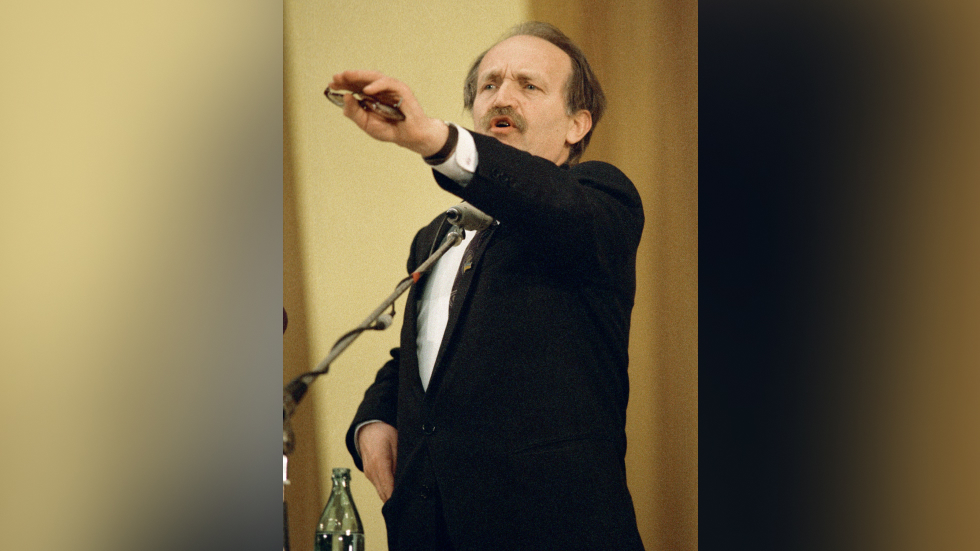
Vyacheslav Chornovol, Ukrainian Rukh popular movement co-president. © Sputnik/Igor Kostin
For Our and Your Freedom
The protest of Dzyuba, Stus and Chornovol signified that the Ukrainian intelligentsia’s struggle had moved to a qualitatively new stage. Whereas, earlier, everything had been limited to muted discontent voiced in kitchens and creative circles, in 1965, dissidents began instigating acts of public protest. Three months after the scandalous premiere, Dziuba wrote Internationalism or Russification?
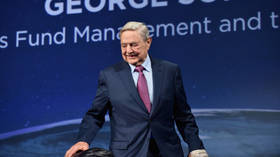
Read more
In his book, the author accuses the Soviet leadership of forcibly Russifying Ukrainians, asserting that the party had adhered to the ideology of great-power chauvinism since Stalin’s time. In his opinion, the only way to end the oppression of the Ukrainian people was to return to the Leninist national policy.
The book was mainly distributed in samizdat (banned literature copied and disseminated by readers – RT), but in 1968, it was published in the emigrant magazine Modernity in Munich. This magazine was supported by the Ukrainian Supreme Liberation Council, which was associated with the OUN and its one-time leader, the Nazi collaborator Stepan Bandera. Dziuba’s book found wide resonance in society and provoked a reaction from the authorities – the author was expelled from the Writers’ Union.
However, Petr Shelest, being the de facto head of the Ukrainian SSR and a Politburo member, allowed the book to be published for official use and sent copies to regional party committees for review.
Attempt to Stop the Nationalists
After Soviet troops entered Czechoslovakia in 1968, the Ukrainian intelligentsia feared a new tightening of the screws and prepared a letter of protest against political persecution addressed to the leaders of the USSR – Leonid Brezhnev, Alexey Kosygin, and Nikolay Podgorny, two of whom (Brezhnev and Podgorny) were Ukrainian themselves.
It was signed by 139 figures in culture and the arts. The first among the signatories was director Parajanov.
It is not surprising that rumors concerning an underground terrorist Bandera organization spread in the Ukrainian SSR soon thereafter. Subsequently, some of the most active signatories were arrested. One of the letter’s organizers, Alla Gorskaya, who had discovered secret NKVD execution sites back in 1962, died under strange circumstances. Her father-in-law allegedly struck her with an axe out of personal spite, and then repented and immediately committed suicide. It remains a mystery how an elderly man who walked with a cane after suffering a heart attack could have cut a person down with one blow. One of the unofficial versions attributes the murder to the KGB, which allegedly repeatedly summoned the artist, demanding that she remove her signature from the protest letter.

V. Parakhin, A. Gorskaya, G. Sinitsa, V. Zaretsky. Donetsk, 1965.
Despite the murder of Alla Gorskaya, the Ukrainian national movement did not cease its activities. Firstly, an underground culture developed – especially in avant-garde art circles in Kiev, Kharkov, Lvov, and Uzhgorod. Secondly, the Ukrainian Helsinki Group, which was established in 1976, intensified its human rights activities, while simultaneously raising national issues.
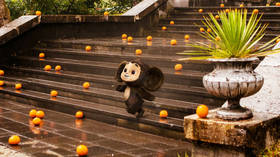
Read more
Responding to attempts to publicize violations of the Ukrainian intelligentsia’s rights, the Soviet government promptly suppressed the activities of human rights defenders. From 1977 to 1979, dozens of people were arrested and sent to camps under anti-Soviet laws, primarily Article 62, part 1, of the Criminal Code of the Ukrainian SSR on ‘Anti-Soviet Agitation and Propaganda’. Among them were Viacheslav Chornovol, Levko Lukyanenko, and Vasily Stus. The latter’s guilt was acknowledged in court by his own lawyer, Viktor Medvedchuk (later chairman of Ukrainian President Leonid Kuchma’s administration and co-chairman of the ‘Opposition Platform – For Life’ party – RT). In the end, the poet was sentenced to 10 years in prison and 5 years’ exile, which turned out to be a death sentence for him.
While well aware of the possible consequences, the dissidents did not stop fighting for civil and national rights. Not all chose this path, however. Some, having supported the intelligentsia at first, later not only distanced themselves from it, but even actively supported their persecutors. For example, USSR State Prize laureate Ivan Drach criticized Ukrainian nationalists who “come mainly from the western edge of our land.” However, his break with the dissidents did not prevent him from later becoming a figure in the national movement or from participating in the preparation of Ukraine’s Declaration of Independence in 1991.
His colleague in the creative workshop, Dmitriy Pavlichko, was at one time suspected of participating in the Ukrainian Insurgent Army (the combat wing of the OUN). It is not surprising that he is considered one of the patriarchs of the Ukrainian national movement in today’s Ukraine, as he began advocating for war with Russia in 1991. However, in the 1960s and 1970s, he actively supported Western Ukraine’s annexation by the USSR. For example, he is the author of the following verse: “I am the son of a simple logger, Hutsul from the Carpathian Mountains. Fate smiled sweetly on me, In the glow of the Kremlin stars!”
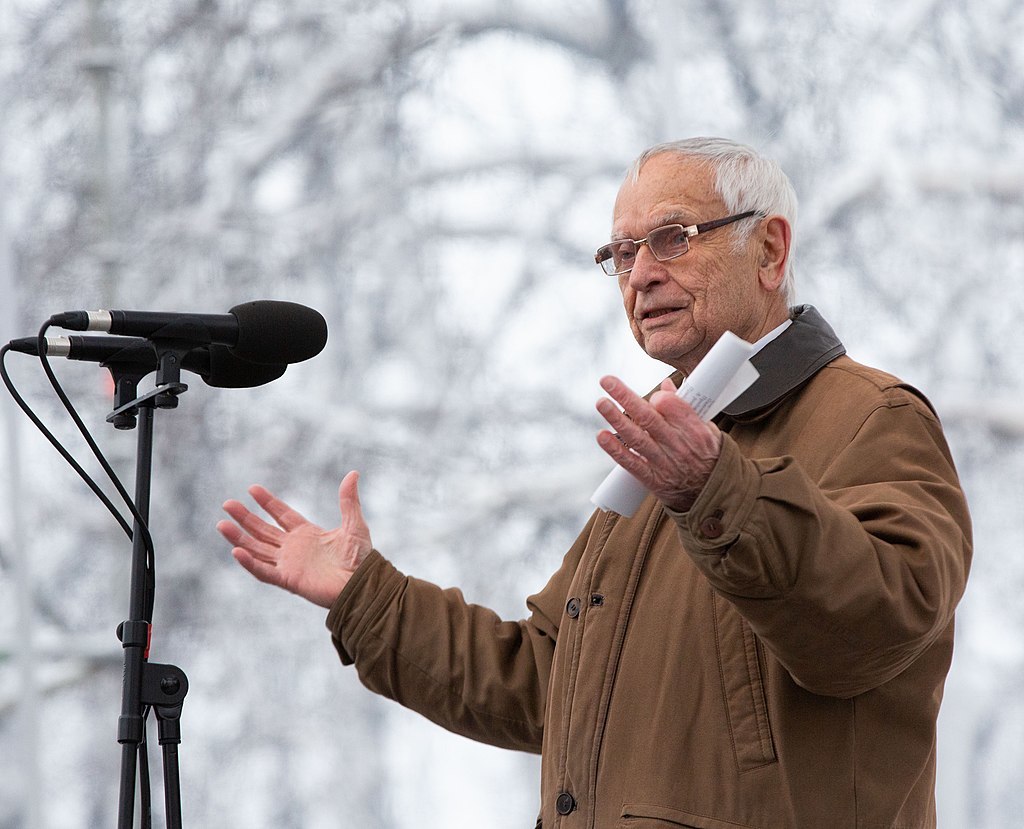
Dmytriy Pavlychko. © Wikipedia
Independence Movement
In 1985, Mikhail Gorbachev came to power in the Soviet Union and initiated Perestroika. During the wave of democratization of social and political life, the ‘People’s Movement of Ukraine for Perestroika’, better known as Rukh (from Ukrainian ‘movement’), was created in February of 1989. This was an extremely motley coalition including both moderate communists and radical nationalists, first headed by Ivan Drach, and later shortened its name to simply ‘People’s Movement of Ukraine’.

Read more
After some time, leadership of Rukh fell to Viacheslav Chornovol, who enjoyed great authority among Ukrainian dissidents thanks to his ten-year struggle with the Soviet regime. However, there were also sincere communists like Drach and Pavlychko in the party. Many well-known Ukrainian nationalist leaders who played a huge role in the 2014 Maidan coup and the subsequent war in the Donbass launched their political careers in Rukh, including Oleg Tyagnibok, leader of Ukraine’s ultra-nationalist Svoboda party, and Andrey Parubiy, former speaker of Ukraine’s parliament, the Verkhovna Rada.
In the parliamentary elections of March 1990, the Democratic Bloc, which included Rukh, received 111 out of 450 seats, becoming the second largest party in the Supreme Soviet of the Ukrainian SSR. The parliament was controlled by the Communist majority, the so-called ‘Group of 239’, led by Aleksandr Moroz. Nationalists demanding that Ukraine separate from the USSR were supported mainly by residents of Western Ukraine and, partly, Kiev. However, it was Rukh that became the driving force that led Ukraine to independence in 1991.
Events developed at lightning speed. In July of 1990, the Supreme Soviet of the Ukrainian SSR adopted the Declaration of State Sovereignty of Ukraine, but it had no practical consequences. However, in the wake of rumors about the signing of an updated Union Treaty that would fix the Ukrainian SSR as part of the USSR, students from universities in Kiev and Lviv demanded a new parliamentary election and went on hunger strike, dubbed the ‘Revolution on Granite’.
At the height of events on October Revolution Square (now Independence Square), 150 people were taking part in the hunger strike. After two weeks, the head of the Ukrainian SSR’s Council of Ministers, Vitaly Masol, resigned. But despite some opposition successes, by the summer of 1991, prospects for real Ukrainian independence appeared illusory. In a March referendum, more than 70% of the inhabitants of the Ukrainian SSR voted for the preservation of the USSR.
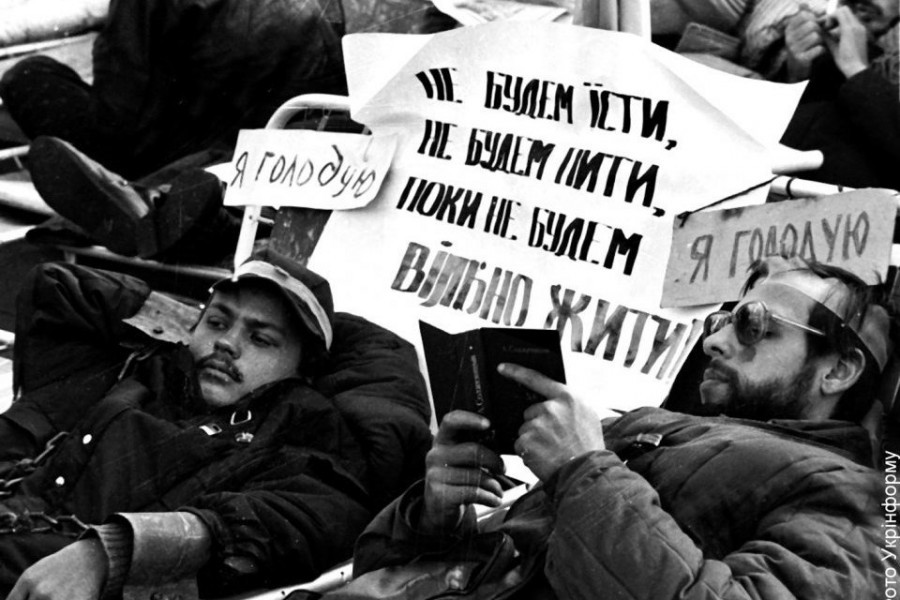
Participants of hunger strike during ‘Revolution on Granite’, Kiev, 1990
A Logical Outcome
At a festival on August 17, 1991, Rukh’s leader, Chornovol, acknowledged that the probability of independence was extremely slim. However, just two days later, a coup took place in Moscow, when the State Committee for Emergency Situations (GKChP) emerged to prevent the signing of a new Union Treaty, which would have turned the USSR into a confederation. As a result, the Supreme Soviet of the Ukrainian SSR adopted the ‘Act of Declaration of Independence of Ukraine’ on August 24. The activities of the Communist Party of the Ukrainian SSR were subsequently suspended, and then banned.

Read more
The collaboration of Ukrainian nationalists, Communist directors, and Soviet-Party nomenclature, amplified by the administrative resources of the Ukrainian SSR’s vertical power structure, made it possible to rally public support. On December 1, 1991, a new referendum was held, in which more than 90 percent of residents voted for an independent Ukraine. Ironically, in Ukraine’s first presidential elections, which were held simultaneously, residents voted, in essence, for the preservation of the Ukrainian SSR by electing party apparatchik Leonid Kravchuk, while nationalist candidates Viacheslav Chornovol and Levko Lukianenko couldn’t garner even a third of the votes between them.
Moreover, in 1992, Chornovol and Rukh had already begun to actively promote the federalization of Ukraine “on the principles of nationalism and national unity.” Vladimir Cherniak, a member of Rukh’s Central Committee, stated that the transition to federalism “will accelerate the process of state-building, as it will free the central authorities from solving regional problems, making it possible to focus their attention on global issues.”
However, such initiatives received no response from the population, and disagreements between party members almost resulted in a split. The old constellation of nationalists that had led Ukraine to independence began to exit the political scene. In their place, more radical organizations emerged that demanded total Ukrainization and war with Russia. Among them were the Ukrainian National Assembly, which had its own armed subdivision dubbed the Ukrainian Nationalist Self-Defense, as well as the Social Nationalist Party of Ukraine, which was renamed Svoboda in 2004.
By Alexander Nepogodin, an Odessa-born political journalist, expert on Russia and the former Soviet Union.


